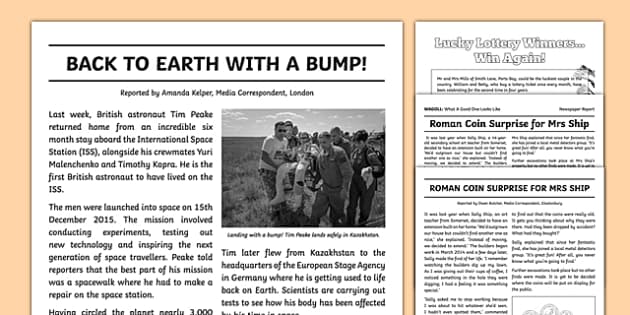News Articles Fundamentals Explained
News Articles Fundamentals Explained
Blog Article
The Ultimate Guide To News Articles
Table of ContentsNot known Details About News Articles Some Of News ArticlesUnknown Facts About News Articles6 Easy Facts About News Articles ExplainedThe Definitive Guide for News Articles
Excellent understanding of different subjects offers pupils an one-upmanship over their peers. Even though electronic and social media sites are easily available, we need to not fail to remember exactly how essential it is to read the papers. Moms and dads must attempt and inculcate the practice of reviewing a newspaper as a daily regimen to continue the legacy of the adored print tool.Information tales likewise include at least one of the adhering to vital qualities relative to the designated target market: closeness, prominence, timeliness, human rate of interest, oddity, or repercussion.
Within these restrictions, information stories also aim to be comprehensive. Among the larger and a lot more revered papers, fairness and equilibrium is a major aspect in providing information.
Papers with an international audience, for instance, tend to utilize a much more official design of composing. The particular selections made by a news electrical outlet's editor or editorial board are typically gathered in a style guide; typical design guides include the and the US Information Design Publication. The major goals of news writing can be summarized by the ABCs of journalism: accuracy, brevity, and clarity.
Some Known Incorrect Statements About News Articles
Generally, journalists will not make use of a long word when a short one will certainly do. They use subject-verb-object building and brilliant, energetic prose (see Grammar). They supply anecdotes, examples and metaphors, and they rarely depend upon generalizations or abstract concepts. Information authors try to prevent using the exact same word greater than when in a paragraph (occasionally called an "resemble" or "word mirror").
Headlines often omit the topic (e.g., "Jumps From Boat, Catches in Wheel") or verb (e.g., "Feline lady lucky"). A subhead (likewise subhed, sub-headline, subheading, caption, deck or dek) can be either a subservient title under the main heading, or the heading of a subsection of the article. It is a heading that comes before the major message, or a team of paragraphs of the main text.

Additional signboards of any of these kinds may show up later on in the post (specifically on succeeding web pages) to tempt additional analysis. Such billboards are also utilized as reminders to the short article in other sections of the magazine or site, or as advertisements for the piece in other publication or websites. Typical structure with title, lead paragraph (summary in vibrant), various other paragraphs (information) and get in learn the facts here now touch with information.

Example of a hard-lead paragraph NASA is proposing one more area project. The budget requests around $10 billion for the project.
The NASA statement came as the firm requested $10 billion of appropriations for the task. An "off-lead" is the 2nd crucial front web page news of the day. The off-lead shows up either in the leading left corner, or directly below the lead on the. To "hide the lead" is to begin the article with history information or information of second importance to the viewers, requiring them to find out more deeply right into an article than they need to have to in order to uncover the crucial factors.
Some Known Details About News Articles
Common usage is that a person or more sentences each create their own paragraph. Reporters generally explain the company or framework of an information story as an upside down pyramid. The important and most intriguing aspects of a story are placed at the start, with sustaining details complying with in order of diminishing significance.
It permits people to explore a subject to just the depth that their inquisitiveness takes them, and without the imposition of information or subtleties that they might take into consideration pointless, however still making that information readily available to more interested readers. The inverted pyramid structure likewise enables write-ups to be cut to any approximate length throughout design, to suit the room available.
Some writers start their stories with the "1-2-3 lead", yet there are many type of lead offered. This layout invariably starts with a "5 Ws" opening up paragraph (as explained over), complied with by an indirect quote that serves to sustain a significant component of the first paragraph, and afterwards a direct quote to support the indirect quote. [] A twist can describe numerous things: The last tale current broadcast; a "satisfied" story to finish the show.
Longer posts, such as magazine cover articles and you could look here the items that lead the within sections of a paper, are known as. Attribute tales differ from straight information in a number of ways.
News Articles Fundamentals Explained
The reporter usually details interactions with interview subjects, making the piece a lot more individual. A function's initial paragraphs frequently relate an appealing moment try this site or occasion, as in an "unscientific lead". From the details of a person or episode, its view promptly expands to abstract principles concerning the story's topic. The section that signifies what a function is around is called the or signboard.

The Editor's Toolbox: A Referral Overview for Beginners and Professionals (2001) Allan M. Siegal and William G. Connolly. The New York City Times Manual of Design and Usage: The Official Style Guide Made Use Of by the Writers and Editors of the Globe's Most Authoritative Newspaper (2002) M. L. Stein, Susan Paterno, and R.
Report this page